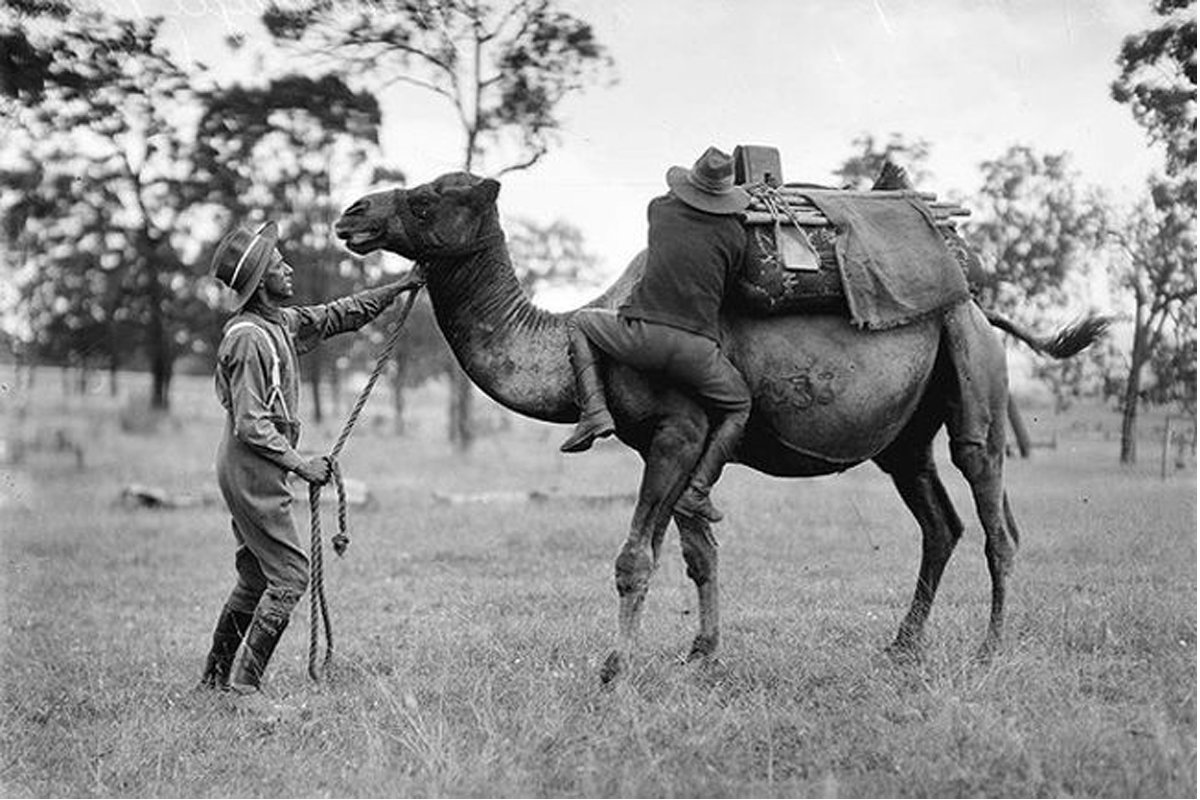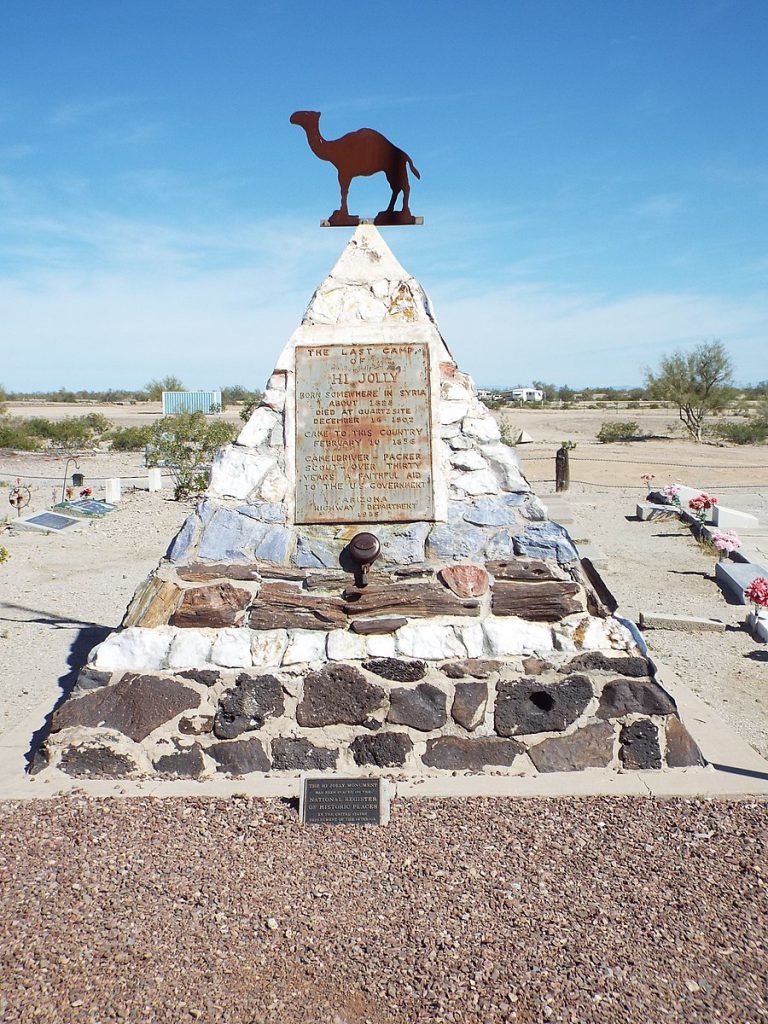
Soldiers train with a dromedary camel in this photo of the U.S. Camel Corp, which was active from 1856 to 1866 and headquartered at Old Camp Verde near Kerrville. The Army formed the unit to see how the desert animals would perform in the American Southwest. Photo courtesy of Wikipedia Commons (https://www.gosanangelo.com/story/news/2020/03/15/before-civil-war-us-camel-corps-explored-southwest/5041396002/)
The unforgivable mountainous terrain, vast deserts, and impassable rivers of the American Southwest were great challenges for the U.S. Army during the expansion in the 1830s. Alternate solutions debated between U.S. Army Lieutenant George H. Crosman and E. H. Miller included the possibility of acquiring camels to be used as pack animals as opposed to the standard method of using mules and horses.
“For strength in carrying burdens, for patient endurance of labor, and privation of food, water & rest, and in some respects speed also, the camel and dromedary [as the Arabian camel is called] are unrivaled among animals,” states the report they sent to Washington, D.C.
“The ordinary loads for camels are from seven to nine hundred pounds each, and with these they can travel from thirty to forty miles a day, for many days in succession. They will go without water, and with but little food, for six or eight days, or it is said even longer. Their feet are alike well suited for traversing grassy or sandy plains, or rough, rocky hills and paths, and they require no shoeing.”

Despite the report and their findings in 1836, Congress stalled the idea for nearly two decades. Following the Mexican-American War, the U.S. had acquired a large stretch of land that was nearly impossible to traverse using just horses, wagons, and mules. When Major Henry C. Wayne, a West Point graduate and veteran of the Mexican-American War, met Crosman, the pair realized a shared interest as camel enthusiasts. Wayne had requested to experiment with camels in 1847, but Congress was skeptical when it came to the beasts of burden.
Wayne, however, continued to bring awareness to anyone who would listen. His resiliency paid off when Jefferson Davis, who later became the Secretary of War and president of the Confederate States, accepted the peculiar concept in 1855. Wayne was appointed the leader of the excursion and formed the U.S. Camel Corps with a $30,000 grant from Congress. He traveled to Europe to visit the London Zoo Gardens in the United Kingdom and to talk with the French military in Paris who had experience in camel-handling in Algeria.

Wayne valued the expertise of the British and French military of their usage of camels in North Africa and, after several discussions, purchased 34 camels from Turkey, Egypt, and Tunisia. The camels were loaded onto the USS Supply, where the camels and crew braced severe weather conditions during their three-month voyage across the Atlantic. Lieutenant David Dixon Porter, the captain of the USS Supply, had the foresight to ensure the cargo hold where the camels were held was in tip-top shape. Prior to the expedition, he implemented necessities such as hoists, slings, and stable areas that helped keep the animals safe during the excursion.
Since American soldiers had to be trained in camel handling once they arrived back in Texas, camel drivers were hired to care for, maintain, and be drivers of the camels. One of these drivers was Philip Tedro, a Syrian native who had changed his name to Hadji Ali after he converted to Islam. He became one of the best-known camel drivers and was sometimes called “Hi Jolly” because of the difficulty American speakers had pronouncing his Arabic name.
“On being landed and feeling solid earth beneath them, they became excited to an almost uncontrollable degree, rearing, kicking, crying out, breaking halter, tearing up pickets, and by other fantastic tricks demonstrating their enjoyment of the liberty of the soil,” Wayne wrote after the one-humped dromedary camels arrived in Indianola, Texas, on March 14, 1856.

The USS Supply was ordered back to Egypt for an additional 44 camels, while the U.S. Camel Corps conducted several field experiments that determined whether the camels could out-perform other animals. The camels’ mettle was cumulatively tested during a 1,200-mile survey mission from New Mexico to California in the summer of 1857.
“My admiration for the camels increases daily with my experience with them,” wrote Edward Beale, the leader of the wagon road survey caravan. “The harder they are put to the test, the more fully they seem to justify all that can be said of them. They pack water for others four days under a hot sun and never get a drop; they pack heavy burdens of corn and oats for months, and never get a grain; and on bitter greasewood and other worthless shrubs they not only subsist, but keep fat.”
Although the camel program was viewed as a success by those who had participated in it, the experiment was abandoned in 1866 when the American Civil War broke out. The camels worked on farms, were donated to zoos, and were sometimes reported in random sightings that led to mythical tales of wandering camels in the deserts of the Southwest United States.
One camel, though, continued his military service during the American Civil War. This camel was nicknamed “Old Douglas” by the members of the Confederacy that he served alongside. Old Douglas was killed by a Union sharpshooter, and a memorial tombstone was erected in a cemetery in Vicksburg, Mississippi.

Matt Fratus is a history staff writer for Coffee or Die. He prides himself on uncovering the most fascinating tales of history by sharing them through any means of engaging storytelling. He writes for his micro-blog @LateNightHistory on Instagram, where he shares the story behind the image. He is also the host of the Late Night History podcast. When not writing about history, Matt enjoys volunteering for One More Wave and rooting for Boston sports teams.
BRCC and Bad Moon Print Press team up for an exclusive, limited-edition T-shirt design!
BRCC partners with Team Room Design for an exclusive T-shirt release!
Thirty Seconds Out has partnered with BRCC for an exclusive shirt design invoking the God of Winter.
Lucas O'Hara of Grizzly Forge has teamed up with BRCC for a badass, exclusive Shirt Club T-shirt design featuring his most popular knife and tiomahawk.
Coffee or Die sits down with one of the graphic designers behind Black Rifle Coffee's signature look and vibe.
Biden will award the Medal of Honor to a Vietnam War Army helicopter pilot who risked his life to save a reconnaissance team from almost certain death.
Ever wonder how much Jack Mandaville would f*ck sh*t up if he went back in time? The American Revolution didn't even see him coming.
A nearly 200-year-old West Point time capsule that at first appeared to yield little more than dust contains hidden treasure, the US Military Academy said.












